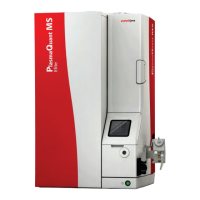Function and setup of the PlasmaQuant MS PlasmaQuant MS product family
26
Orifice
Retaining clamp ring
Fig. 9 Sampler cone installed in the PlasmaQuant MS
Orifice
Fig. 10 Skimmer cone installed in the PlasmaQuant MS
The vacuum is maintained by differential pumping, whereby the pressure is reduced in
three stages. The first and most critical stage produces a beam of particles in a high
vacuum system from an atmospheric pressure source by means of the sampler and
skimmer cone. The interface cones are separated by a well-defined distance, with the
space between them kept at a pressure of about 5 mbar by a fore-line roughing pump.
A small fraction (around 0.1 %) of the plasma passing through the sampler cone
enters the orifice at the tip of the skimmer cone and passes into the second stage of
the vacuum system. This arrangement allows most of the plasma that comes through
the sampler cone to be removed, while providing a representative sample of the
plasma for analysis. On its way after the skimmer cone the plasma loses free electrons
and becomes a mixture of positively charged ions, neutral atoms and molecules.
The first and second stage of the vacuum system are separated by a gate valve that
allows the first stage to be brought to atmospheric pressure for maintenance while the
rest of the system remains under vacuum. The second stage of the vacuum system is
kept at a pressure of around 10
-4
mbar by a turbomolecular pump.

